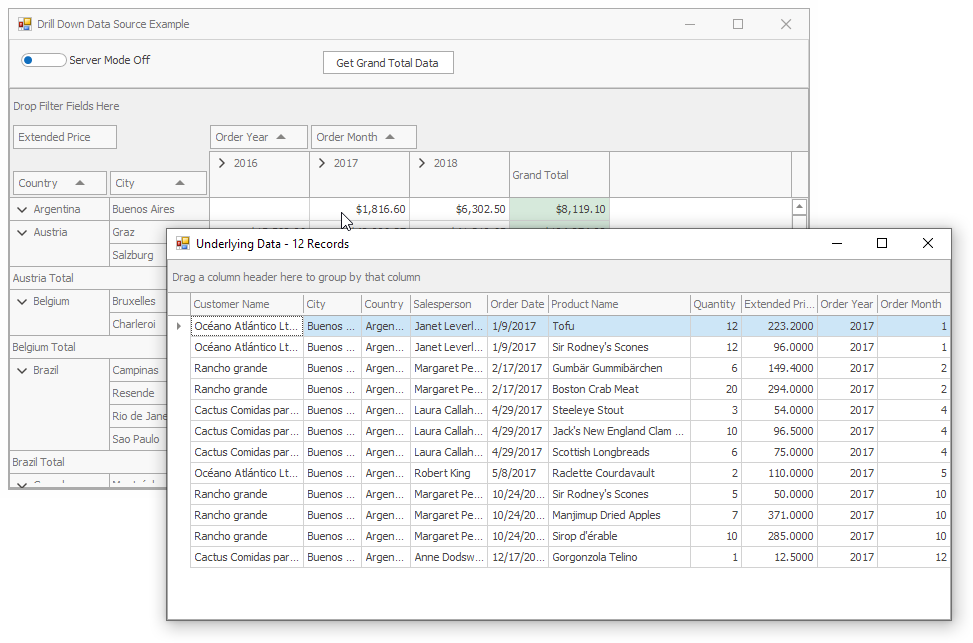PivotGridControl.CreateDrillDownDataSource(Int32, Int32, Int32, List<String>) Method
Returns data records used to calculate a summary value for the specified cell. Allows you to specify the columns and limit the number of records to return.
Namespace: DevExpress.XtraPivotGrid
Assembly: DevExpress.XtraPivotGrid.v24.2.dll
NuGet Package: DevExpress.Win.PivotGrid
#Declaration
public PivotDrillDownDataSource CreateDrillDownDataSource(
int columnIndex,
int rowIndex,
int maxRowCount,
List<string> customColumns
)#Parameters
| Name | Type | Description |
|---|---|---|
| column |
Int32 | A zero-based visible column’s index of the column. Set it to -1 to obtain the column’s Grand Total. |
| row |
Int32 | A zero-based visible row’s index. Set it to -1 to obtain the row’s Grand Total. |
| max |
Int32 | An integer value that specifies the maximum number of data rows to be returned. -1 to retrieve all rows. |
| custom |
List<String> | A list of columns to be returned. |
#Returns
| Type | Description |
|---|---|
| Pivot |
A Pivot |
#Remarks
Important
The custom
If you use the CreateDrillDownDataSource method in OLAP mode, take note of the following limitations:
| OLAP Server | Note |
|---|---|
| MS SQL Server Analysis Services 2000 | The custom |
| MS SQL Server Analysis Services 2005 and 2008 | If the custom |
| Any OLAP Server | If returned records contain a column used as a filter in Pivot Grid, the returned data are filtered. |
| Any OLAP Server | The Create |
| MS SQL Server Analysis Services - all versions | Multiple filter items selected in a Filter field results in an exception. |
In server and OLAP modes, the CreateDrillDownDataSource method returns only visible fields. To get hidden field values, use the method’s overloads with the customColumns parameter which allow you to specify the columns to return.
Note
For an example of use refer to the Create topic.
#Example
This example demonstrates how to obtain the records from the control’s underlying data source for a particular cell. Double-click a cell to invoke a form that contains a grid to show the underlying data.
Note
The complete sample project How to: Display Underlying (Drill-Down) Records is available in the DevExpress Examples repository.
The primary data source is the Northwind database contained in the SQL Server data file NW.mdf. The application can use the BindingSource component or the LinqServerModeDataSource instance to retrieve the data from the database. A LinqServerModeDataSource data source is a queryable data source, and it forces the PivotGrid to operate in server mode. Click the Server Mode toggle switch control to switch from one data source to another.
When you double-click the PivotGrid cell, the PivotGridControl.CellDoubleClick event occurs. The following CreateDrillDownDataSource method overrides are called to obtain the list of records associated with the selected cell:
- If Server Mode is not enabled, the e.CreateDrillDownDataSource(Int32) method returns a data source that contains the columns retrieved from the original data source as well as the columns which the PivotGrid creates.
- If Server Mode is enabled, the e.CreateDrillDownDataSource(int maxRowCount, List<string> customColumns method returns a data source that contains the columns shown in the PivotGridControl and the columns explicitly specified in the method parameter.
You can also click the Get Grand Total Data button to call the PivotGridControl.CreateDrillDownDataSource method and display all data records that the PivotGridControl uses to show the summarized data.

using DevExpress.XtraEditors;
using DevExpress.XtraGrid;
using DevExpress.XtraGrid.Views.Grid;
using DevExpress.XtraPivotGrid;
using System;
using System.Collections.Generic;
using System.Drawing;
using System.Windows.Forms;
namespace DrillDownDataSourceExample
{
public partial class Form1 : DevExpress.XtraEditors.XtraForm
{
bool serverMode = false;
public Form1()
{
InitializeComponent();
pivotGridControl1.CellDoubleClick += PivotGridControl1_CellDoubleClick;
// This line of code is generated by Data Source Configuration Wizard
linqServerModeSource1.QueryableSource = new DrillDownDataSourceExample.DataClasses1DataContext().Invoices;
}
private void PivotGridControl1_CellDoubleClick(object sender, DevExpress.XtraPivotGrid.PivotCellEventArgs e)
{
PivotDrillDownDataSource drillDownDataSource;
if (serverMode)
drillDownDataSource = e.CreateDrillDownDataSource(25, new List<string> { "ShipName" });
else
drillDownDataSource = e.CreateDrillDownDataSource(25);
XtraForm dataform = CreateDrillDownForm(drillDownDataSource);
dataform.ShowDialog();
dataform.Dispose();
}
private void Form1_Load(object sender, EventArgs e)
{
// TODO: This line of code loads data into the 'nWDataSet.Invoices' table. You can move, or remove it, as needed.
this.invoicesTableAdapter.Fill(this.nWDataSet.Invoices);
SetPivotGridDataSource();
}
private XtraForm CreateDrillDownForm(PivotDrillDownDataSource dataSource) {
XtraForm form = new XtraForm();
GridControl grid = new GridControl();
grid.Parent = form;
grid.Dock = DockStyle.Fill;
grid.DataSource = dataSource;
grid.DataSource =
form.Bounds = new Rectangle(100, 100, 800, 400);
GridView gridView1 = new GridView();
grid.MainView = gridView1;
gridView1.Columns["OrderDate"].DisplayFormat.FormatType = DevExpress.Utils.FormatType.DateTime;
form.Text = string.Format("Underlying Data - {0} Records", dataSource.RowCount);
return form;
}
private void toggleSwitch1_Toggled(object sender, EventArgs e)
{
serverMode = ((ToggleSwitch)sender).IsOn;
SetPivotGridDataSource();
}
private void SetPivotGridDataSource()
{
if (serverMode)
pivotGridControl1.DataSource = linqServerModeSource1;
else
pivotGridControl1.DataSource = invoicesBindingSource;
}
private void btnGrandTotal_Click(object sender, EventArgs e)
{
PivotDrillDownDataSource drillDownDataSource = pivotGridControl1.CreateDrillDownDataSource();
Form dataform = CreateDrillDownForm(drillDownDataSource);
dataform.ShowDialog();
dataform.Dispose();
}
}
}